Tamaki Kawakubo at Evermay
By Stephen Brookes • The Washington Post • August 19, 2012
Among the more intriguing additions to Washington’s music scene this summer has been “Overtures,” a new series of chamber music concerts at the elegant Evermay estate in Georgetown. The series was designed to showcase gifted young performers, and in its sold-out closing concert Friday night it did exactly that, with a stunning and at times almost volcanic recital by violinist Tamaki Kawakubo.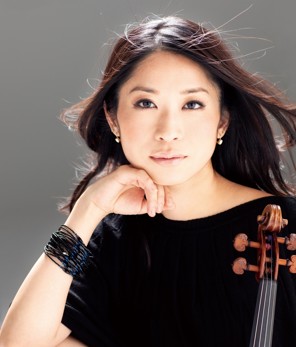 At first glance, Kawakubo doesn’t cut a particularly imposing figure. Slight, soft-spoken and dressed in a gown that looked as though she’d just pulled it out of a paper bag, she closed her eyes and launched into the “Chaconne” movement from Bach’s Partita No. 2 in D Minor, for solo violin. But it was immediately clear that Kawakubo, still in her early 30s, is a ferocious and absolutely fearless player. The Chaconne is one of the most towering works in the repertoire, and it tends to eat lesser violinists alive. But Kawakubo turned in an electrifying and extraordinarily powerful performance, shorn of all dross and shimmering with elemental mysteries: 15 minutes of pure musical magnificence.
At first glance, Kawakubo doesn’t cut a particularly imposing figure. Slight, soft-spoken and dressed in a gown that looked as though she’d just pulled it out of a paper bag, she closed her eyes and launched into the “Chaconne” movement from Bach’s Partita No. 2 in D Minor, for solo violin. But it was immediately clear that Kawakubo, still in her early 30s, is a ferocious and absolutely fearless player. The Chaconne is one of the most towering works in the repertoire, and it tends to eat lesser violinists alive. But Kawakubo turned in an electrifying and extraordinarily powerful performance, shorn of all dross and shimmering with elemental mysteries: 15 minutes of pure musical magnificence.
The rest of the evening seemed designed to balance the monumental Bach with more human-scaled works. Kawakubo was joined by the fine pianist Grace Cho for Mozart’s Sonata in E Minor, K. 304, and it was pure delight to watch Kawakubo — nostrils flaring, eyes a little wild — unleash its complex, perfect little storms. She has, it seems, just about everything: near-flawless technique, precise dramatic instincts and a naturalistic approach to phrasing. Combined with the rich sound of her 1779 Guadagnini (lent to her by the S&R Foundation, the backers of the series), it all made for a riveting performance.
Mozart’s graceful and more lighthearted Sonata in B-flat, K. 378 closed out the recital, which, though relatively brief, felt completely satisfying. Kawakubo responded to the standing ovation with Vittorio Monti’s slyly sensual “Czardas.” And adding to the evening’s many pleasures was an announcement that the Overtures series would be starting up again in November for a winter season — good news for the Washington chamber music scene.
Davitt Moroney at the Museum of American History
By Stephen Brookes • The Washington Post • August 13, 2012
Things are heating up in the bare-knuckle world of competitive harpsichord playing this week as the Westfield International Harpsichord Competition gets underway at the University of Maryland. Twenty-five young players from around the world are duking it out in a savage bid for glory, and the finals (scheduled for Saturday, and open to the public) won’t be pretty.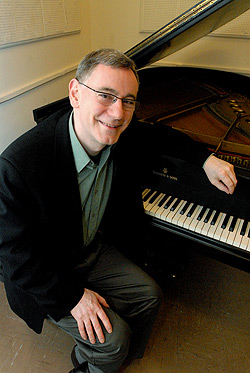 Although, to tell the truth, they probably will be kind of pretty — and even ravishing — if the performance on Sunday night by the British harpsichordist Davitt Moroney is any indication. Moroney is one of the most accomplished players in the world, marrying deep scholarship with a lively musical imagination, and he presented a program of 17th- and early 18th-century music at the Hall of Musical Instruments of the National Museum of American History that showcased the harpsichord’s subtle, elusive and often overlooked eloquence.
Although, to tell the truth, they probably will be kind of pretty — and even ravishing — if the performance on Sunday night by the British harpsichordist Davitt Moroney is any indication. Moroney is one of the most accomplished players in the world, marrying deep scholarship with a lively musical imagination, and he presented a program of 17th- and early 18th-century music at the Hall of Musical Instruments of the National Museum of American History that showcased the harpsichord’s subtle, elusive and often overlooked eloquence.
Playing on four of the museum’s antique and highly individual instruments, Moroney treated the harpsichords as full partners. “We have to listen to them, and work out how they want to be played,” he said as he stood (or rather, stooped) at a tiny 1620 virginal to draw out the gossamer beauty of Henry Purcell’s Suite in D Major, then switched to a 1694 harpsichord by Nicolaus DeQuoco to achieve the richer, bigger sound needed for Louis Couperin’s Pieces in E Minor and three complex dances by William Byrd.
Francois Couperin’s Eight Preludes required a more robust harpsichord from 1745, and the evening closed with the colorful Suite in D Minor by Louis Marchand (a composer usually remembered for bowing out of a harpsichord duel with Johann Sebastian Bach), played on a 1760 instrument by Benoist Stehlin.
Moroney’s playing was superb throughout; this is introspective music that comes alive not through raw power or burning passion, but from the quieter depths of understanding, and Moroney showed himself to be a poet of the meditative, thoughtful phrase. The intriguing evening ended on a touching note as Moroney, after taking a quick bow, gestured affectionately at the harpsichord — inviting the audience to applaud it, as well.
Simone Dinnerstein at the Phillips Collection
By Stephen Brookes • The Washington Post • July 16, 2012
What to make of Simone Dinnerstein ? This once-obscure pianist burst into the spotlight five years ago, when her self-financed recording of Bach’s Goldberg Variations shot to the top of the charts and made her an international superstar. But her distinctively dreamy, almost romantic approach has divided listeners into warring camps. Her devotees say her warmth and sensitivity open a unique window onto Bach, but skeptics dismiss her playing as idiosyncratic, dumbed-down and aimed, more or less, at soft-headed teenage girls. So when Dinnerstein sat down at the piano on Sunday afternoon at The Phillips Collection for an all-Bach program, every ear in the room tilted forward to see what the fuss was about. And as the opening work — the fifth of Bach’s French Suites — unfolded, Dinnerstein’s strengths and weaknesses quickly became clear.
So when Dinnerstein sat down at the piano on Sunday afternoon at The Phillips Collection for an all-Bach program, every ear in the room tilted forward to see what the fuss was about. And as the opening work — the fifth of Bach’s French Suites — unfolded, Dinnerstein’s strengths and weaknesses quickly became clear.
First, the bad — of which, unfortunately, there was plenty. The Allemande lurched clumsily out of the gate, tripping over its awkward phrasing, followed by a Courante that rushed about aimlessly, full of odd dynamics and eccentric shifts in tempo. The Sarabande was taken at such a glacial pace that Dinnerstein lost the line entirely, and the entire Suite finally just laid down, heaved a pitiful sigh and died.
It went on and on like that throughout the afternoon. Dinnerstein is undoubtedly gifted, but there was a kind of willful, adolescent intensity to her playing that took the place of real thought, and it was hard to find a solid core in anything she played. She seemed to have no use for subtlety; every musical point was spelled out in big letters and then underlined, and you were left with the sense that “meaning” was being ladled over the music like some thick, unpleasant gravy.
But for all the self-indulgence and obviousness — and this is the maddening thing about Dinnerstein’s playing — there were moments of absolutely stunning beauty, as well. They happened when the pianist reined in her personality and let the music take center stage. The Gigue of the English Suite No. 3, for instance, was exhilarating, masterfully conceived and beautifully executed, and the two Partitas were marked by brilliant counterpoint and melodies that blossomed with breathtaking grace. For all its flaws, there’s no denying the compelling warmth in Dinnerstein’s playing. It touches people deeply — and won her a heartfelt standing ovation.
Gloria Cheng at Gildenhorn Recital Hall
By Stephen Brookes • The Washington Post • July 15, 2012
Pianist Gloria Cheng is one of the most adventurous interpreters of contemporary music around, and in a spectacular recital on Friday at the University of Maryland’s Gildenhorn Recital Hall — consisting almost entirely of works written in the 21st century — she showed just how surprising, eclectic and emotionally engaging the contemporary piano repertoire can be.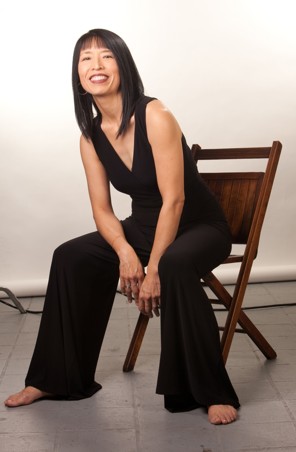 The evening, which is part of the William Kapell International Piano Competition and Festival, ranged from the elegiac to the downright funny. John Cage’s deceptively simple “Dream” (1960) was paired with Kaija Saariaho’s shimmering, glissando-drenched “Prelude” (2006) to make a quiet opening to the recital.
The evening, which is part of the William Kapell International Piano Competition and Festival, ranged from the elegiac to the downright funny. John Cage’s deceptively simple “Dream” (1960) was paired with Kaija Saariaho’s shimmering, glissando-drenched “Prelude” (2006) to make a quiet opening to the recital.
But Cheng soon shifted gears. Harrison Birtwistle’s playful “Betty Freeman: Her Tango” (2001) is “a cheeky little piece,” as Cheng noted, although she played it with an odd solemnity, as if explaining a joke rather than telling it. The more prickly side of new music was represented by Pierre Boulez, whose “Une Page d’Ephemeride” (2005) proved that the old firebrand — now in his late 80s — is as abrasive and unapologetic as ever. And five of the “Twelve Preludes” (2007) by Pulitzer Prize-winning composer Bernard Rands confirmed that admirable, immaculate music is still being produced in the halls of academia.
Some of the most captivating music of the evening, though, came not from the big names but from younger composers. Steven Andrew Taylor’s luminous “Satellite” (2002-03) was a delight — down to the surprising little sweep of her fingers across the piano wires that closes the work. And “Starlight” (2009) by David Liptak evoked with quiet lyricism the beauties of the night sky. Esa-Pekka Salonen’s “Dichotomie” (2000) was a brilliant tour de force from a fascinating composer more widely known as a conductor, and Cheng turned in a performance that can only be described as breathtaking.
But it was Oliver Knussen’s “Ophelia’s Last Dance” (2009-10) that most deeply revealed the pianist’s interpretive gifts. A tender, even elegiac piece, it unfolded like an improvisation on a dance-like theme, at turns searching, fragmented, passionate and awash in grief. Cheng seemed to understand it to her bones and played it with dignity, eloquence and grace.
Wolf Trap Singers at the Phillips Collection
By Stephen Brookes • The Washington Post • June 30, 2012
One of the more distinctive things about concerts at the Phillips Collection is the long, labyrinthine stroll you have to take through the galleries to get to the Music Room, which seems to heighten your awareness of the subtle interplay between music and the visual arts. That interplay was at the heart of a recital on Thursday night by four rising young singers from the Wolf Trap Opera Company who presented an intimate, eclectic and individual program of music chosen to accompany paintings from the museum’s collection.Corinne WintersThe multimedia evening, titled “Vocal Colors,” ranged from show tunes to Sibelius and opened with an explosive account of “Fate” (from the musical “Kismet” by Robert Wright and George Forrest), sung by bass-baritone Craig Colclough, with the fine pianist Joseph Li accompanying. With Mark Rothko’s brooding painting “Green and Maroon” projected on a screen behind him, Colclough displayed an easy, down-to-earth confidence in his singing, and there’s an agreeable roughness to his voice that brought a fine edge to the song and turned Irving Fine’s hilarious “Tigeroo” into a tour de force.
Tenor James Kryshak displayed a lighter, softer voice to good effect in Dave Frishberg’s lighthearted “Peel Me a Grape” but shifted deftly into a darker tone for Franz Liszt’s searing “Pace non trovo,” while mezzo-soprano Margaret Gawrysiak contrasted Sam Coslow’s witty “You’ll Have to Swing It (Mr. Paganini)” with a passionate song from Sibelius, both sung with insight and imagination.
But the standout of the evening may have been the lyric soprano Corinne Winters. Almost motionless, staring at some far-off spot in the vicinity of Neptune as she sang, Winters could seem icily elusive at times. No matter: Her voice is exceptionally fine, and her accounts of Claude Debussy’s “Apparition” and Eduard Toldra’s Catalan boating song, “Canco de grumet,” rang with thoughtful, radiant beauty. This is a singer to keep an eye on.
The Vivaldi Project at the Washington Early Music Festival
By Stephen Brookes • The Washington Post • June 11, 2012
For the past six years or so, The Vivaldi Project has been on a mission: to explore not only the music of the early baroque period, but also the astonishingly rich musical language, with its own precise grammar of expression, that underlies that music. The intriguing idea has made the ensemble’s concerts, as it showed Sunday at St. George’s Episcopal Church in Arlington, into events that forge fascinating ties among composers of the time.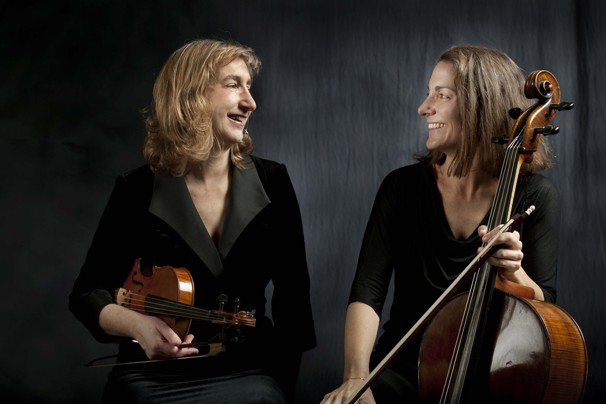 Elizaebth Field and Stephanie VialFor Sunday night’s concert (part of the Washington Early Music Festival, which runs through the end of the month), the ensemble looked at what lead violinist Elizabeth Field called the “tug of war” between Italian and French composers of the baroque. The French tended to be more restrained, with an emphasis on harmony rather than melody, and the Italians were more emotional and freewheeling.
Elizaebth Field and Stephanie VialFor Sunday night’s concert (part of the Washington Early Music Festival, which runs through the end of the month), the ensemble looked at what lead violinist Elizabeth Field called the “tug of war” between Italian and French composers of the baroque. The French tended to be more restrained, with an emphasis on harmony rather than melody, and the Italians were more emotional and freewheeling.
To drive the point home, the group contrasted a quintessentially French work, the Suite from “Thesee” (1675) by Jean-Baptiste Lully, with Arcangelo Corelli’s Sonata in G Op. 3 No. 6. Lully’s music can be hard for modern ears to warm up to; though beautifully made, it’s formal to the point of chilliness, and there's often a mincing, precious quality that’s not to every taste. The Corelli, by contrast, was a vibrant and much earthier piece featuring superb playing by Field with the gifted violinist Allison Edberg, ensemble co-founder Stephanie Vial on cello, Joseph Gascho at the harpsichord and William Simms on theorbo.
No sooner had the Corelli ended, a heart-stopping crack rang out: The neck of Simms’s theorbo (a sort of lute with an extended neck and as many as 20 strings) had snapped. Simms was sidelined, but the group soldiered on with an early Vivaldi sonata and a fascinating trio sonata by Francois Couperin called “L’apothese de Corelli” — a French interpretation of the Italian style.
There were other gems on the program, including a richly textured sonata for four violins by Giovanni Legrenzi, and a fiery little concerto by Vivaldi. But perhaps the most unusual work was the Sonata in C Minor, “Sanguineus und Melancholicus” by C.P.E. Bach, a musical debate between an optimist and a pessimist. Field and Edberg acted out the opposing roles with great charm, and the conversation ended with harmony, hugs and a consensus that the glass is, in fact, half-full.
American Chamber Players at the Kreeger Museum
By Stephen Brookes • The Washington Post • June 10, 2012
It was, for the most part, warm breezes and dappled sunshine at the Kreeger Museum on Friday evening, when the American Chamber Players opened this year’s June Chamber Festival with a program that seemed designed to soothe Washington’s troubled brows. But amid the lilting Debussy and cheerful Brahms appeared one of the darkest, most chilling works in the chamber music repertoire, which received such a stunning performance that it turned what might have been just an entertaining evening into a must-hear musical event.Anna StoytchevaThe concert opened innocuously enough. Anna Stoytcheva and Reiko Uchida delivered a lively, finely polished reading of Debussy’s “Petite Suite” in its original four-hand piano version — a colorful and impressionistic work that never fails to delight. The Kreeger may be the perfect place to hear Debussy’s music, which seems completely at home in the museum’s modern-but-not-too-scary art collection, with its wall-to-wall Picassos and sensuous Henry Moores, and the “Petite Suite” made a smile-inducing start to the evening.
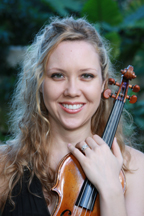 Joanna MaurerBut into the happy glow marched violinist Joanna Maurer. Looking a bit as if she were setting off to war, Maurer barely glanced at the audience before launching into Sergei Prokofiev’s Sonata No. 1 in F Minor. Festival director Miles Hoffman had introduced the piece as “not exactly a laugh riot,” which understates the case: It’s more like staring into an open grave, in the middle of winter, at 3 in the morning. And Maurer (with Stoytcheva at the piano) played it brilliantly in an utterly committed performance that probed relentlessly into the savage, ravaged edges of human experience. It wasn’t an easy listen; devastation runs through this music, and Maurer made no attempt to prettify it. But it was an extraordinary performance. She was playing for keeps, and it showed.
Joanna MaurerBut into the happy glow marched violinist Joanna Maurer. Looking a bit as if she were setting off to war, Maurer barely glanced at the audience before launching into Sergei Prokofiev’s Sonata No. 1 in F Minor. Festival director Miles Hoffman had introduced the piece as “not exactly a laugh riot,” which understates the case: It’s more like staring into an open grave, in the middle of winter, at 3 in the morning. And Maurer (with Stoytcheva at the piano) played it brilliantly in an utterly committed performance that probed relentlessly into the savage, ravaged edges of human experience. It wasn’t an easy listen; devastation runs through this music, and Maurer made no attempt to prettify it. But it was an extraordinary performance. She was playing for keeps, and it showed.
The rest of the evening retreated to more comfortable ground. Hoffman, accompanied by Uchida, turned in an account of Brahms’s amiable Sonata in E-flat for viola and piano, Op. 120, No. 2, that didn’t ruffle any feathers, and Stoytcheva joined Uchida for Schubert’s four-handed “Fantasy” in F Minor, D. 940. The two pianists have a tight rapport and superb technique, but they stayed close to the surface of this extraordinary work, skating over its mysteries as if reluctant to dig too deep.

